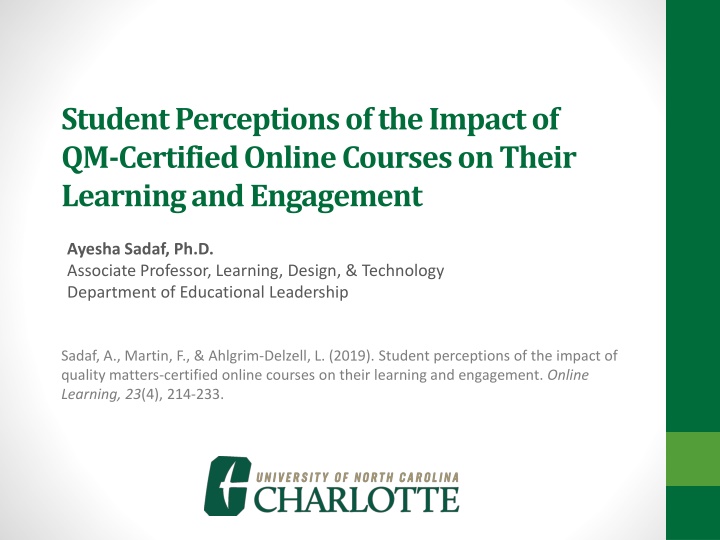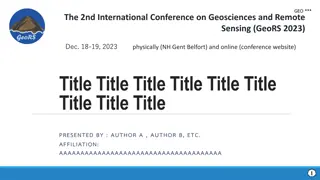
Impact of QM-Certified Online Courses on Student Learning
Explore how Quality Matters (QM) standards enhance online course quality and student engagement based on student perceptions. The study by Ayesha Sadaf, Ph.D., evaluates the effectiveness of QM-certified online courses and their impact on student learning. Discover the significant role of pedagogical support and instructional design in improving student outcomes in online education.
Download Presentation

Please find below an Image/Link to download the presentation.
The content on the website is provided AS IS for your information and personal use only. It may not be sold, licensed, or shared on other websites without obtaining consent from the author. If you encounter any issues during the download, it is possible that the publisher has removed the file from their server.
You are allowed to download the files provided on this website for personal or commercial use, subject to the condition that they are used lawfully. All files are the property of their respective owners.
The content on the website is provided AS IS for your information and personal use only. It may not be sold, licensed, or shared on other websites without obtaining consent from the author.
E N D
Presentation Transcript
Student Perceptions of the Impact of QM-Certified Online Courses on Their Learning and Engagement Ayesha Sadaf, Ph.D. Associate Professor, Learning, Design, & Technology Department of Educational Leadership Sadaf, A., Martin, F., & Ahlgrim-Delzell, L. (2019). Student perceptions of the impact of quality matters-certified online courses on their learning and engagement. Online Learning, 23(4), 214-233.
Background Given the recent rapid growth of online education, ensuring the quality of online course design has gained considerable concern. Many instructors lack pedagogical and instructional support to design and deliver online courses to facilitate student learning. For this reason, Quality Matters (QM) standards have been widely used to assure the quality of online and blended courses. One of the core principles of QM is consideration of learner perspectives and their voices.
Quality Matters (QM) Quality Matters (QM) is recognized worldwide as a highly reliable method for quality assurance in online learning. Scholarly evidence indicates that student learning is improved when instructors design or redesign their online courses using QM standards (Hollowell, Brooks, & Anderson, 2017; Swan, Day, Bogle, & Matthews, 2014; Young, 2014). The QM program uses a rigorous peer-review process and rubric based on standards of best practice, research, and instructional design principles.
Quality Matters Rubric Standards The QM Rubric includes eight general standards that consist of 43 specific sub-standards 1. 2. 3. 4. 5. 6. 7. 8. Course overview & introduction Learning objectives Assessment & measurement Instructional materials Course activities & learner interaction Course technology Learner support Accessibility & usability
Quality Matters Rubric Standards Standards Objectives 1 Course Overview & Introduction Course design is clear to the students and helps them understand how to get started in the course 2 Learning Objectives Learning objectives are clearly stated from a student perspective, are measurable, properly aligned, and easy to understand 3 Assessment & Measurement Assessments are aligned with the learning objectives, are consistent with course activities and resources, clearly explains how the course grades are calculated 4 Instructional Materials Instructional materials are comprehensive to achieve course objectives or competencies 5 Learning Activities & Learner Interaction Learning activities and forms of interaction incorporated in the course motivate students to attain course objectives and promote learning 6 Course Technology Course navigation and technology support student engagement and that are used to achieve learning objectives 7 Learner Support Course provides links to resources for students to access institutional academic policies, technology support, student support services essential to their success 8 Accessibility & Usability Course provides a documentation of accessibility of the course materials, tools, and activities for all students
Engagement Engagement is the ability to hold the attention of an individual or to induce the individual to participate in some sort of activity. Student engagement refers to the extent to which students actively engage by thinking, talking, and interacting with the content of a course, the other students in the course, and the instructor (Dixson, 2015, p. 2). Students engage more with the course content as a result of the more interactive activities designed based on the QM guidelines (Knapp & Paul, 2013; Runyon, 2006).
Learning Learning is the acquisition of knowledge or skills through experience, study, or by being taught. Ally (2004) defines online learning as the use of the Internet to access learning materials; to interact with the content, instructor, and other learners; and to obtain support during the learning process, in order to acquire knowledge, to construct personal meaning, and to grow from the learning experience (p. 7). Legon and Runyon (2007) found student learning and satisfaction increased for courses redesigned using QM criteria.
Previous Findings Legon, Runyon, & Aman (2007) found higher grades and greater student interaction with course materials after redesign of courses using QM standards. Young (2014) found a positive relationship between learners perceptions of course quality with the courses designed to meet the QM Standards. Finley (2005) found that learners were more satisfied in terms of course navigation and requirements to succeed in the QM certified courses. Aman (2009) found a significant positive relationship between learner satisfaction and QM certified courses. Although researchers have been studying outputs of QM standards, research on student perception of their learning and engagement in QM certified courses is limited.
Research Questions The purpose of this study was to examine student perceptions of QM standards on their engagement and learning in QM-certified online courses. 1. What are online student perceptions of the impact of QM standards in QM certified courses on their learning? 2. What are online student perceptions of the impact of QM standards in QM certified courses on their engagement?
Methods Research Design Survey-based study Participants Enrolled in an online Learning, Design, & Technology (LDT) program in the College of Education n= 50 online graduate students 28% males 72% females 23-53 years of age 66% Master s Degree 28% Graduate certificate 6% post-doctorate Spring, Summer, and Fall 2017 UNC Charlotte LDT Program All course are QM certified Program level QM certification Program design and Learner success
Instruments The 43 QM standards within the eight categories were used to create the survey. Each QM standard was rated on a scale from 0 to 3 (no impact, a little impact, some impact, a lot of impact) on two the constructs of learning and engagement. Students were asked the question Please think about each standard and rate how much impact this standard has on your online learning and engagement. Cronbach's alpha as an estimate of internal consistency of student responses was high across all items of the survey (.98) separately for each construct (.94 learning and .97 engagement) There were also two open-ended questions Think about your most recent online course(s). a. Which strategy(ies) impacted you the most for your learning? b. Which strategy(ies) impacted you the most for course engagement?
Data Analysis Descriptive statistics were used to report the participants perception of the impact of the QM survey on their engagement and learning. A table with means and standard deviations was generated to describe the responses for impact on learning and engagement. The open-ended survey question data were coded and categorized into the eight QM rubric categories using constant-comparison approach to further explain the survey results.
Results RQ#1: What are online student perceptions of the impact of QM standards in QM certified courses on their learning? Learning Top two rated QM standards were Course Activities and Learner Interaction (M=2.72) and Learning Objectives (M=2.71). Course Activities and Learner Interaction - highest rated item was 5.1 (M=2.78) Learning activities consistent with objectives. Learning Objectives - highest rated item was 2.2 (M=2.78) Learning objectives consistent with course-level objectives.
Results Open-ended question: The online learning strategies reported by students (n = 50) that impacted their learning the most Survey Categories Frequency Percent Course Activities and Learner Interaction 20 40 Instructional Materials 11 22 Accessibility and Usability 6 12 Learning Objectives 2 4 Assessment and Measurement 2 4
Results RQ#2: What are online student perceptions of the impact of QM standards in QM certified courses on their engagement? Engagement The top two rated QM standards for impact on engagement were Course Activities and Learner Interaction (M=2.76) and Learning Objectives (M=2.60). Course Activities and Learner Interaction - highest rated item was 5.2 (M=2.81) Opportunities for learner interaction. Learning Objectives - highest rated item was 2.4 (M=2.65) Clear relationship between learning objectives and course activities.
Results Open-ended question: The online learning strategies reported by students (n = 50) that impacted their engagement the most Survey Categories Frequency Percent Course Activities and Learner Interaction 15 30 Instructional Materials 7 14 Accessibility and Usability 3 6 Learning Objectives 3 6 Assessment and Measurement 2 4
Discussion Course Activities and Learner Interaction Activities that facilitate interaction are important in online learning Courses designed with QM rubric result in improving student-content interaction (Legon & Runyon, 2007) Students are satisfied instructors provided opportunities to interact in many different ways (Fedynich, Bradley & Bradley, 2015) Intentionally designing courses for increasing students interaction can positively impacts students overall academic achievement (Knapp & Paul, 2013)
Discussion Learning Objectives Learning Objectives was the second highest among the eight categories of QM standards on students learning and engagement. Informing the learners of the objectives at the beginning of instruction, clarifies what is expected of them and assists them in guiding their learning (Reiser & Dick, 1996). Students performance in online graduate course improved because the QM revision focused the mapping of objectives to learning outcomes (Swan, et al., 2011).
Discussion Instructional Material Instructional materials was rated as the second important theme in open-ended items for both learning and engagement Graduate students benefited from having a variety of activities including chat rooms, discussion boards and few synchronous meetings online (Koh, 2004). Reiser and Dick (1996) stated that a significant part of the instructional design process is presenting the instructional material.
Implications Course activities and learner interaction Incorporate collaborative learning activities such as problem- based learning or case-based learning that can create community of learners through peer-peer interactions. Provide opportunities for students to interact with the course content as well as each other through discussion boards, group work, peer review, etc. Learning objectives Use syllabus or course introductions to specifically explain how course activities are aligned with the learning objectives. Create e-lessons at the beginning of every module to introduce weekly activities and clearly explain the learning objectives.
Implications Instructional Materials Use a variety of learning tools and digital media (audio or video), such as YouTube, podcasts, TED Talks, screencasts, PowerPoints, Prezi etc., to enhance student learning and engagement. Use diagrams, tables, pictures, games, simulations, etc. to make content visually appealing to sustain motivation and deeper understanding. Alignment to QM standards Narrowing the search for impact of a QM review to specific groups of standards such as course alignment standards or learner engagement standards can be productive.
Questions? Contact asadaf@uncc.edu Sadaf, A., Martin, F., & Ahlgrim-Delzell, L. (2019). Student perceptions of the impact of quality matters-certified online courses on their learning and engagement. Online Learning, 23(4), 214-233.






















